
KIA Optima / Magentis
Generations Timeline, Specs and Pictures
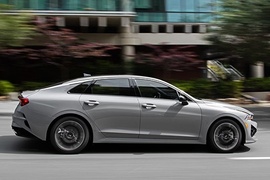
The Korean car-maker Kia unveiled the fifth generation of the Optima K5 in 2019 as a 2020 model year.
It was based on the same platform as the Hyundai Sonata.
Despite the ascending trend for the SUV segment, Kia decided to keep the K5 sedan in its lineup for those who doesn’t look for expeditions and doesn’t need or want an SUV. A light sedan could provide the same comfort and amenities as an SUV but being more fuel-efficient at the same time.
The new design language adopted by Kia for the Optima K5 was different than before, with angular shapes and a “Shark-skin” mesh-grill. It was not an evolution over its predecessor, but more like a leap. Despite being introduced in 2019, the marketing department decided not to fit the taillights with LED as standard, but to offer them on the options list, or only for the upper trim levels. It used the same strategy with headlights, and only the fog lights and the DRLs were with LED as standard.
The interior was another leap, with tons of gadgets and technologies available either as standard or on the options list. The infotainment system was floating on top of the center stack and almost got into the instrument panel. For the gear selector, Kia introduced an “aircraft-like” design, with a flat knob on top of it. The car-maker arranged a comfortable bench and enough legroom and headroom for the rear passengers despite the sloped roofline.
Under the hood, the K5 featured a choice of two engines. The base model featured a 1.6-liter unit while the top version was fitted with a 2.5-liter unit. All of them were turbocharged and feed via a direct fuel injection system. An all-wheel-drive traction system was available, but the 8-speed automatic transmission was fitted as standard.
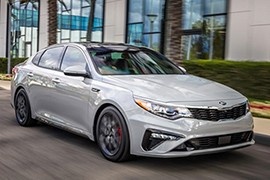
The Kia Optima 2018 features advanced longevity features such as automatic emergency braking, treadmill assistance and lane exit warning.
The LX base models are now strictly powered by the naturally aspirated 2.4-liter inline-four, which continues to blend in with a six-speed automatic transmission. The 1.6-liter inline-four 1.6-liter LX with 1.8-liter battery, which was previously optional, is now only available to prepare for the EX equipment. The Optima EX also comes with new standard features such as cruise control and LED fog lights, while a heated steering wheel joins the option menu.

The fourth generation of the Kia Optima was launched in July 2015 for the Korean market and, later on, in other countries.
The Optima represented another design success signed by the former Audi designer Peter Schreyer. Its lines and features were another step toward a mass-market vehicle with premium touches, both inside and outside.
While the wheelbase of the 2015 Optima was increased by 10 mm (0.4”) the overall length increased only with half than that. But a different interior layout made more room available for the rear passengers inside the medium-sized sedan. For the exterior look, the design team made a European approach, with a raked windshield and a sport-sedan look for the vehicle. On the front fascia, the swept headlights enhanced the sporty appearance of the vehicle.
Inside, the cabin was larger than on the former Optima. Besides the slightly longer wheelbase, the wider vehicle made more shoulder-room for the passengers. To improve comfort, more soft materials were used for the interior, with higher quality contact surfaces. New features were added, such as heated and ventilated front seats. The Nappa leather was offered as an option. For the infotainment system, an 8” touch-screen display was available and it included the Apple CarPlay and Android Auto connectivity. The sound system was created by Infinity and included a 14-speaker arrangement.
Under the hood, there were three engine choices: a 2.0-liter turbo, a 2.4-liter naturally aspirated, and a new 1.6-liter turbo. While the first two are mated to a standard 6-speed automatic, the latter sent its torque to the wheels via a 7-speed dual-clutch gearbox.

The third generation of the Kia Optima was launched at the 2010 New York International Auto Show.
It had the same technical platform as the Hyundai Sonata or the i40, featuring an all-wheel independent suspension with a front-engine and a front-wheel-drive architecture.
Designed at Kia’s studios in Frankfurt, Germany and Irvine, California, the Optima is longer, wider and lower than the Magentis it replaces. The sportier profile look is signed by Peter Schreyer, following a new design language featured on the Kia Forte and Kia Sorento, and using the Korean carmaker’s new corporate grille, known as the Tiger Nose.
The Optima’s engine lineup has been replaced with the universal GDI 2.4-liter 4-cylinder unit, either mated to a 6-speed automatic transmission with Eco dash display, or a 6-speed manual transmission. On other markets outside the U.S., there are other engines also available, such as an inline-4 with a 2.0-liter displacement gasoline or two turbodiesel variants with a 1.7-liter and a 2.0-liter displacement, respectively. These can also be mated either with a 6-speed manual or a 6-speed automatic transmission.
The interior of the Optima features iPod connectivity and Bluetooth. In 2013, Kia offered a UVO infotainment system built in cooperation with Microsoft, with a larger touchscreen and integrated backup camera. It also features, depending on trim level and options, heated rear seats, a navigation system, heated and cooled front seats and a panoramic moonroof.
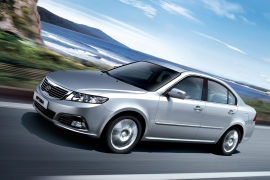
The Optima sedan was unveiled at the 2008 New York Motor Show as a 2009 model year.
It was a major facelift for the already known Kia Optima/Magentis.
The 2009 model was the facelift for the second generation of the Optima, which was introduced in 2005. Unlike that, the new version featured angled headlights instead of the bulky ones from before. But underneath the bodywork, there was the same platform with independent suspension in all corners.
The headlights were narrowed to create a sharper look and the fog-lights were installed lower in the front apron. The grille was reshaped with the integration of the “Tiger-nose” touch imagined by Peter Schreyer, the chief-of-design from Hyundai-Kia. Another improvement was the addition of an extra inch in the overhangs, both front, and back, to enhance safety.
Inside, the dashboard was completely changed, with new electronic devices installed. The standard system featured MP3 compatibility and Sirius satellite radio. The rest of the center stack and console were mildly changed. Due to its generous wheelbase, it offered enough legroom for the rear passengers.
Under the hood, there was also a new generation of engines, based on the Theta II family, together with some of the older units. For the European versions, a 2.0-liter diesel unit was installed. The standard transmission for some versions was a 5-speed manual, while the other received a newly developed 5-speed automatic.
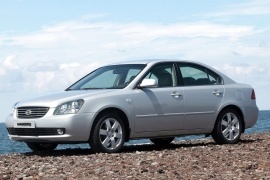
Kia unveiled the Optima at the 2006 North American International Auto Show in Detroit, and it was the last piece o the puzzle in its lineup.
With the Optima, the Korean carmaker completed the three-year regeneration process of its lineup. It was a mid-size sedan built on the same base as the Hyundai Sonata. It was built to offer good comfort and decent performance at an affordable price. The result matched the promise, and the Optima was sold well around the world, bearing different names such as the Magentis in Europe or Lotze in South Korea.
Peter Schreyer signed the design, and its influence was obvious. It was starting with the big headlights swept-back on the sides and top of the fenders. The grille was wide with horizontal slats and featured the Kia oval logo in the middle. From its sides, the Optima offered a simple sedan look with a sloped rear window.
Inside, a big sound system occupied the center stack’s upper side and, underneath it, the designer placed the climate control buttons. In the instrument cluster, the manufacturer decided to offer a four dial panel with the coolant temperature and the fuel level placed in the middle, on the upper side. It was the same idea used by Audi, and that was not a big surprise since Schreyer was an important designer for the German brand.
Under the hood, Kia offered a wide choice of diesel and gasoline engines. For the U.S. market, the Korean carmaker installed only gasoline versions.
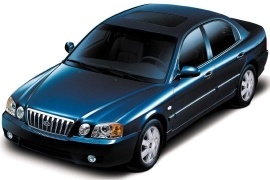
Just three years, give or take a few months after it unveiled the first generation of the Optima/Magentis lineup, Kia introduced a mid-life cycle refresh for its flagship model.
The Korean carmaker thought that if it would change the generations faster, will catch up with its main competitors on the market. Somehow, that system worked quite well for Kia, and its evolution was faster than anyone predicted. But not any facelift might be a good reason to buy the newest version.
Stylewise, Kia didn’t know exactly how to design its cars and make them appealing to the customers. It tried different lines and shapes. Some of them worked, some didn’t. While the 2001 model featured classic-looking horizontal headlights, the 2003 updated version came with individual round headlamps and additional ones on the front fascia’s outer side. They looked strange, to say at least.
Inside, the carmaker didn’t try too hard to hide its low-budget vehicle expertise. The car offered cloth seats for the base trim levels but installed standard air-conditioning, power windows and locks, power mirrors, and a sound system that worked well. Kia kept the split-folding rear seats. A leather-clad interior and a premium sound system were fitted as standard on the top trim level, while the sunroof was on the options list.
Under the hood, Kia installed a 2.0-liter engine for the entry-level version, while the top trim level received a V-6 unit. For the U.S. market, an inline-four 2.4-liter was available on the base model.

Kia started to improve its lineup and introduced the Optima/Magentis in 2001 as a 2002 model for specific markets.
After years of offering simple, modest vehicles, Kia launched an assault on the mid-size segment with the Optima, which was also known as Magentis outside the U.S. The Korean carmaker was part of the Hyundai group and used the same platform as the fourth generation of the Sonata. It was a surprising move that gets them into more families’ garages. Even though it cost twice as much as the Kia Rio sedan, it was still cheaper than the Honda Accord or Toyota Camry.
From the outside, the Optima/Magentis surprised with its angular-looking headlights, while the biodesign era was not completely over. They tried a new-edge design, and it worked well. Some might say that the car looked even better than its sister, the fourth Sonata, with or without a facelift. Its chromed grille looked upmarket, even though it was not even close to the premium segment. Its only downside was the wheels’ size, which was only 14” with an option for 15” light-alloy.
Inside, there was enough room for four adult passengers, thanks to its 2.7 meter (106.3”) wheelbase. Depending on the engine version and trim level, Kia offered an automatic transmission, leather seats, and sunroof. The standard features list was long and included AC, split-folding rear seats (even though it was a sedan), side airbags, and power windows.
Under the hood, Kia dropped a 2.4-liter inline-four and a 2.7-liter V6. Both were paired as standard to a 5-speed manual transmission and an option for a four-speed automatic. The independent suspension in all corners was another good feature to ad more comfort.























































